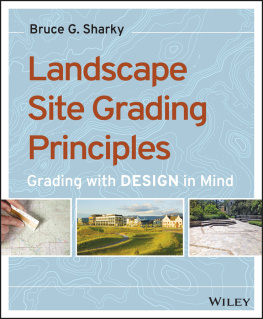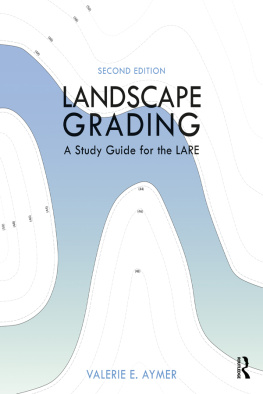
Cover image: Wiley
Cover design: Measurement, topography and courtyard Images: Bruce Sharky; Center landscape Image: Design Workshop
This book is printed on acid-free paper.
Copyright 2015 by John Wiley & Sons, Inc. All rights reserved
Published by John Wiley & Sons, Inc., Hoboken, New Jersey
Published simultaneously in Canada
No part of this publication may be reproduced, stored in a retrieval system, or transmitted in any form or by any means, electronic, mechanical, photocopying, recording, scanning, or otherwise, except as permitted under Section 107 or 108 of the 1976 United States Copyright Act, without either the prior written permission of the Publisher, or authorization through payment of the appropriate per-copy fee to the Copyright Clearance Center, 222 Rosewood Drive, Danvers, MA 01923, (978) 750-8400, fax (978) 646-8600, or on the web at www.copyright.com. Requests to the Publisher for permission should be addressed to the Permissions Department, John Wiley & Sons, Inc., 111 River Street, Hoboken, NJ 07030, (201) 748-6011, fax (201) 748-6008, or online at www.wiley.com/go/permissions.
Limit of Liability/Disclaimer of Warranty: While the publisher and author have used their best efforts in preparing this book, they make no representations or warranties with the respect to the accuracy or completeness of the contents of this book and specifically disclaim any implied warranties of merchantability or fitness for a particular purpose. No warranty may be created or extended by sales representatives or written sales materials. The advice and strategies contained herein may not be suitable for your situation. You should consult with a professional where appropriate. Neither the publisher nor the author shall be liable for damages arising herefrom.
For general information about our other products and services, please contact our Customer Care Department within the United States at (800) 762-2974, outside the United States at (317) 572-3993 or fax (317) 572-4002.
Wiley publishes in a variety of print and electronic formats and by print-on-demand. Some material included with standard print versions of this book may not be included in e-books or in print-on-demand. If this book refers to media such as a CD or DVD that is not included in the version you purchased, you may download this material at http://booksupport.wiley.com. For more information about Wiley products, visit www.wiley.com.
Library of Congress Cataloging-in-Publication Data:
Sharky, Bruce.
Landscape site grading principles: grading with design in mind / Bruce Sharky.
pages cm
Includes bibliographical references and index.
ISBN 978-1-118-66872-6 (cloth : acid-free paper); 978-1-118-93139-4 (ebk); 978-1-118-93140-0 (ebk)
1. Landscape construction. 2. Building sites. 3. Grading (Earthwork) 4. Landscape architecture. I. Title.
TH380.S53 2014
624.1'52dc23
201400839
Printed in the United States of America
10 9 8 7 6 5 4 3 2 1
Gracas Nolita
Preface
Landscape Site Grading Principles embodies a new approach for teaching site grading for designers who think and learn visually. Knowledge and skill in site grading are essential areas of service for landscape architects and allied design professionals. Demonstration of competency in site grading is a significant component in the test for obtaining professional licensure to practice landscape architecture. Site grading plans must not only solve practical requirements and meet various governmental standards but also create landforms that contribute to the aesthetic ambition of the overall landscape site and architectural design concepts. Landscape Site Grading Principles will provide students with the necessary background, knowledge, and problem-solving skill set to develop landscape-grading plans that meet standards of care related to meeting public health, safety, and welfare design standards.
The predominant site grading textbooks used in site grading courses take an engineering approach. Landscape Site Grading Principles teaches grading principles through visual means to better meet the needs of the visual learner. It provides a hands-on approach to allow students to better understand grading principles. This is accomplished by integrating text with illustrative diagrams and actual examples photographed in the everyday landscape.
Finding a more effective approach to teaching site grading has been a goal of mine. I have found that students seem to better grasp grading concepts when I utilize a more hands-on approach. For example, I have taken blackboard chalk out with me on campus walks with students to draw hypothetical contours and spot elevations on the ground, walls, and other surfaces. I find doing this helps students visualize what they have struggled to visualize reading existing textbooks. I have also used PowerPoint presentations, but this method, while visual, does not necessarily help students visualize how to apply my description of the images on the screen to manipulating the site contours and making the required spot elevation calculations for their assignments. While most students view grading and other technology-related courses as something other than design, in fact grading is just as much a design subject, and just as visual, as any other aspect of landscape design. Although landscape grading does involve a certain amount of computation, many students do not readily see what they are creating from calculating spot elevations and reconfigured contours. With the publication of Landscape Site Grading Principles, faculty will be able to help students more readily visualize grading concepts and solutions and become successful at solving site grading problems while creating aesthetic solutions.
Site grading education continuously evolves, and curricula change, reflecting the changing nature of the design professions and the nature of professional practice. Site grading is typically taught as a stand-alone course in a landscape architecture and architecture curriculum technical stream. Although this approach will most likely continue, there is a growing consideration of greater integration of site grading and technology with the design studio stream. Landscape Site Grading Principles is written to address the ambition for more effective integration of design and site grading by placing emphasis on the design implications of site grading.
Landscape Site Grading Principles recognizes that students enter landscape architecture and related professions with an academic preparation and set of life experiences influenced greatly by computers and other technology. Walking around a high school or college campus, one will quickly notice that most of the students heads are tilted downward as they walk across campus or sit amongst their friends, with thumbs flying, either texting their friends or doing Google searches. College students come into academic life well versed in and adept at a range of computer skills, and they expect the computer to be their primary means of doing their course assignments, including those in landscape architecture studio and technology courses. While these students are highly computer literate, they may not have a sound grasp of the physicality of the world. This is particularly true of concepts of scale and of the substance and dimensions of the material world they pass through every day. This statement may not apply for everyone, but it is important for technical coursessuch as site gradingto give students more hands-on experience of the materials and elements they will be designing. Landscape Site Grading Principles
Next page











